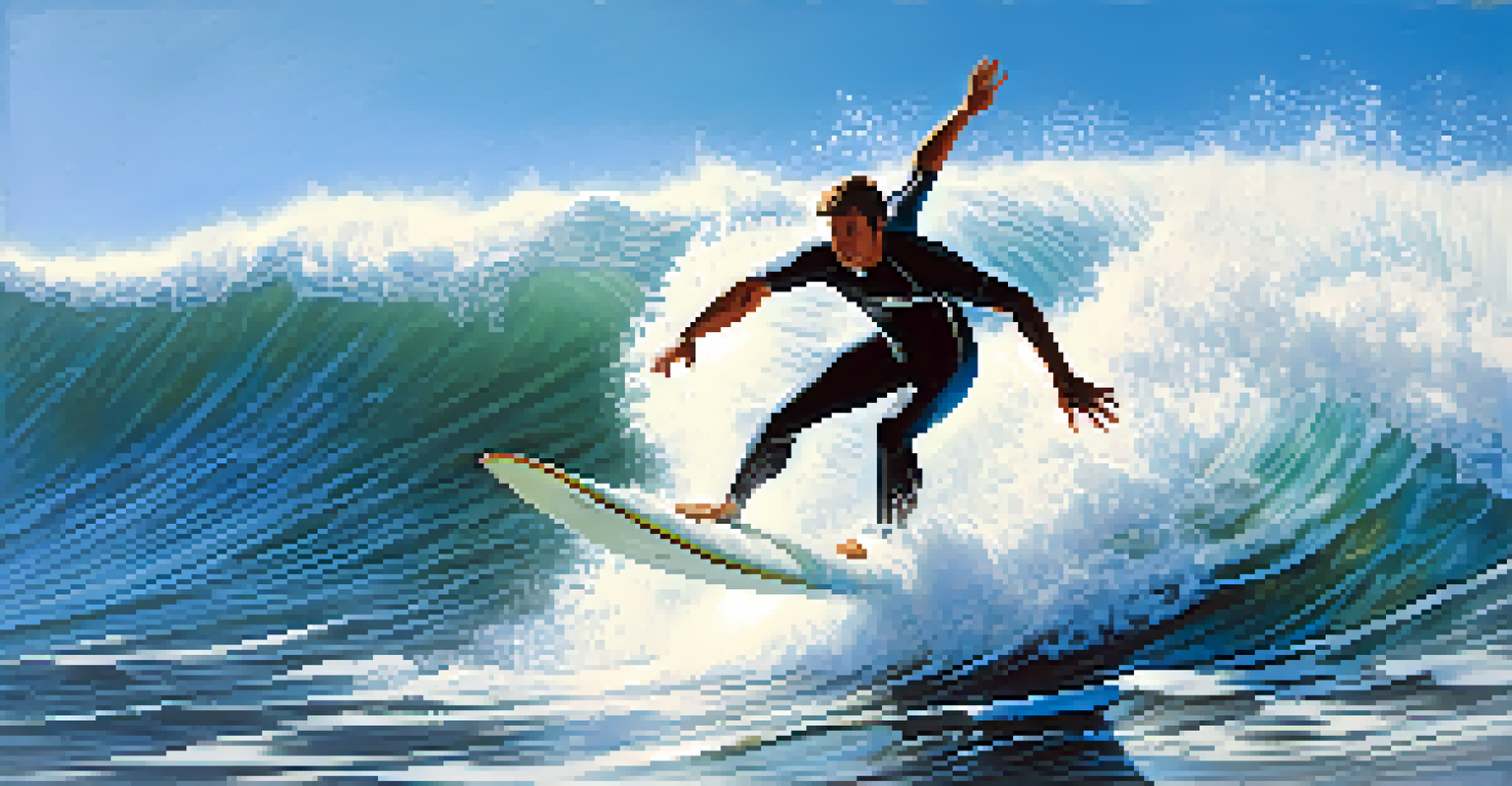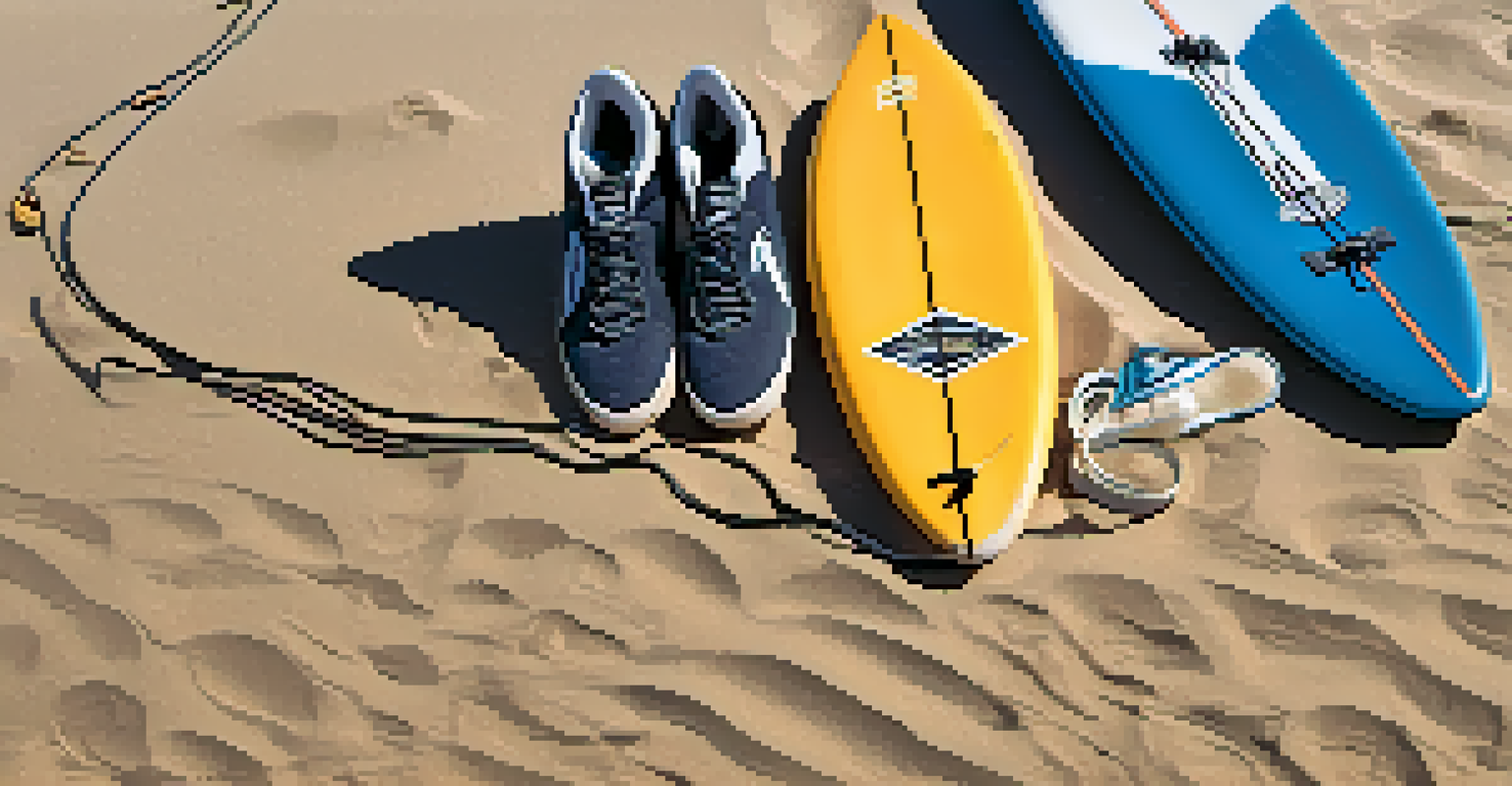Surfing Safety Tips: Staying Safe While Riding the Waves

Understanding Surf Conditions for Safety
Before you even hit the water, it’s crucial to understand the surf conditions. This means checking the swell size, tide, and wind direction. Each of these factors can drastically change how the waves behave, and thus how safe they are for surfing.
The ocean is a mighty harmonist.
For instance, small, gentle waves might be perfect for beginners, while large, powerful waves can be dangerous. Websites and apps that provide surf reports can be invaluable tools. They offer up-to-date information that can help you gauge the most suitable conditions for your skill level.
Always remember, just because a beach looks inviting doesn’t mean it’s safe. Taking a few minutes to assess the surf can go a long way in keeping you safe while you catch those waves.
Investing in the Right Surf Gear
Your surfing experience can be greatly influenced by the gear you use. A good quality surfboard that matches your skill level is a must. For beginners, a longer, wider board offers better stability and balance, making it easier to ride the waves.

In addition to the board, don’t overlook other essential gear like a wetsuit, leash, and wax. A wetsuit can protect you from cold water and potential abrasions, while a leash ensures your board stays close by, preventing it from becoming a hazard to yourself and others.
Know Surf Conditions for Safety
Understanding swell size, tide, and wind direction is essential to ensure a safe surfing experience.
Investing in the right gear not only enhances your performance but also ensures your safety in the water. The right equipment can make all the difference when you’re out there riding the waves.
Practicing Good Surf Etiquette
Surf etiquette is the unspoken set of rules that makes surfing a safer and more enjoyable experience for everyone. For instance, always respect the right of way in the water, which means that the surfer closest to the peak of the wave has priority. Ignoring this can lead to collisions and injuries.
Surfing is the most beautiful sport in the world. It's the only sport where you can be in nature and be at one with the ocean.
Additionally, take a moment to acknowledge other surfers. A friendly nod or wave can go a long way in fostering a positive atmosphere in the water. This sense of community can enhance everyone’s experience and encourages a culture of respect.
By practicing good surf etiquette, you not only keep yourself safe but also contribute to a better surfing environment for everyone around you. It’s all about sharing the waves and having fun!
Staying Aware of Your Surroundings
Being aware of your surroundings is vital for surfing safety. This means keeping an eye on other surfers, potential hazards, and changing weather conditions. Waves can shift rapidly, and a moment of distraction can lead to dangerous situations.
Pay attention to local wildlife as well, such as jellyfish or sharks. While shark attacks are rare, it’s important to be conscious of your environment and the creatures that inhabit it. If you notice unusual behavior from local wildlife, it’s best to exit the water.
Invest in Quality Surf Gear
Having the right surfboard, wetsuit, and other equipment enhances performance and safety in the water.
Ultimately, staying alert and aware can help you anticipate potential dangers before they become an issue. This mindfulness is key to having a safe and enjoyable surfing experience.
Knowing Your Limits and Skill Level
One of the most important surfing safety tips is knowing your own limits. It can be tempting to try and ride bigger waves as you gain confidence, but pushing yourself too hard can lead to accidents and injuries. Start with smaller waves and gradually progress as your skills improve.
It’s also wise to recognize when you’re feeling fatigued. Surfing is physically demanding, and being tired can impair your judgment and reaction time. If you feel exhausted, it’s better to take a break rather than risk injury.
By respecting your personal limits, you not only keep yourself safe but also enhance your overall surfing experience. Remember, it’s not about how big the waves you can ride are, but about enjoying the journey.
Understanding Rip Currents and How to Escape Them
Rip currents are powerful, narrow channels of water that flow away from the shore, and they can be dangerous for surfers. Recognizing the signs of a rip current, such as water that appears choppy or foamy, can help you avoid them. If you find yourself caught in one, staying calm is essential.
To escape a rip current, swim parallel to the shore for a short distance before heading back to the beach. Trying to swim directly against a rip current can quickly lead to exhaustion, so it's crucial to understand this technique.
Practice Good Surf Etiquette
Respecting the right of way and acknowledging fellow surfers fosters a safer and more enjoyable surfing environment.
By being knowledgeable about rip currents and how to handle them, you can stay safe and enjoy your time in the water without fear. Awareness is key to navigating the waves confidently.
Recognizing and Responding to Injuries
Injuries can happen even in the safest conditions, so it’s important to know how to recognize and respond to them. Common surfing injuries include cuts, bruises, or even more serious issues like concussions. Familiarizing yourself with basic first aid can be incredibly beneficial.
If you or someone else gets injured, assess the situation calmly. For minor cuts, rinse the area with fresh water and apply a bandage. However, for more serious injuries, it’s crucial to seek medical attention as soon as possible.

Being prepared for potential injuries not only helps you stay safe but also ensures that you can enjoy your surfing sessions with confidence. Knowing that you're equipped to handle emergencies adds an extra layer of security.
The Importance of Surfing with a Buddy
Surfing with a buddy is one of the best safety measures you can take. Having someone with you means that you can look out for each other, share tips, and enjoy the experience together. Plus, it’s always more fun to ride the waves with a friend.
In case of an emergency, having a buddy can make all the difference. They can assist you if you get into trouble or even alert lifeguards if necessary. This added layer of safety can give you peace of mind while you’re out in the water.
So, whether you’re a seasoned surfer or just starting out, grab a friend and hit the waves together. Not only will it enhance your experience, but it will also keep you both safe while you enjoy the thrill of surfing.